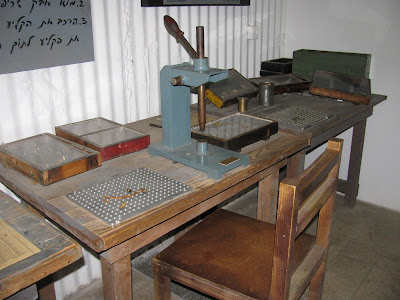I am going to be honest and admit that these photos were taken a few years ago. They somehow slipped through the net and I never got round to blogging about The Ayalon Institute. Of course I haven't really visited any new places over the last few months, so this is my opportunity to play catch up and show you a place that I may have visited some time back but is still of great interest to this day.
The Ayalon Institute, Makhon Ayalon, was a secret ammunition factory disguised as part of a kibbutz. In a factory the size of a tennis court, members of the "A" Scout Group and others produced 9mm bullets for the Sten submachine guns used by Palmach fighters. (The Palmach was a special military force of the Haganah - the underground military organization of pre-State Palestine.)Beginning in the 1930s Zionist leaders in British Mandatory Palestine determined that they were going to need machinery and guns to defend themselves and to fight for their independence. While manufacturing guns clandestinely proved relatively easy to do, it was more challenging to make bullets for the guns. A group of people decided to build a munitions factory under a kibbutz, which is a communal area of land designed for a specific purpose such as farming. The area was near a British base.
Twelve machines needed for cartridge production (punching, drilling, cutting etc.) were successfully purchased in Poland in 1938. Because of the international situation at the time, the machines could only be shipped as far as Beirut, Lebanon, where they were stored for nearly four years in a Haganah warehouse. With the help of Jews serving in the British army, the machines were finally brought into Palestine by train.
The site for the future factory - Kibbutz Hill in Rehovot - was chosen for several reasons. It had previously been an agricultural training camp where pioneers would go for training in kibbutz life before moving on to establish cooperatives around the country. The British were already familiar with kibbutz life activities there and would likely not suspect anything. Secondly, because it was a hill, underground construction could take place without disrupting the outside appearance of the hill. Lastly, a nearby train station provided reliably strong noise to cover construction and operation of the factory.
In an impressively short time of three weeks, the hill was dug out and a large underground chamber with nearly 2-foot-thick (0.5m) concrete walls and ceiling was built. Above ground, the sort of buildings used in an ordinary kibbutz - dining room, community hall, children's house etc. - were erected. A laundry and a bakery were also constructed. A big hole used to lower the machines underground was covered by the brick oven of the bakery and the chimney of the bakery became part of the ventilation system for the workers. Its counterpart was hidden in the technical system of the laundry, while the industrial washing machine, which covered the noise and smell of the factory, was movable and hid the secret entrance to the underground factory. Because the washing machine needed to be constantly in use the kibbutz opened a laundry service. Surrounding kibbutzim sent their clothes to be washed for a small fee and even the British brought their uniforms to be taken care of!
Kibbutz members in the manufacturing hall of the Ayalon Institute.


Working conditions were hard and lack of sunlight paled the skin of the workers, putting their cover stories of working in the fields at stake and increasing their risk of illness due to lack of vitamin D. A UV lamp was therefore installed underground to tan their skin to avoid suspicion. Toilets were put in and their content pumped to the kibbutz's sewage system.
There is an interesting story about how copper sheeting, the raw material that was needed for the bullets, was obtained. Applications for import licenses were submitted to the authorities. When asked why so much copper was needed the explanation was given that it would be used to make lipstick cases. The explanation seemed plausible and the import licenses were approved!
Once the bullets were produced, they were smuggled out of the factory in the false bottom of milk cans, milk being an unsuspicious commodity for a kibbutz. Later, fuel was delivered to the kibbutz by lorry at night. The lorry driver would enter the kibbutz, knock a secret code at the door of the bakery, climb down to the factory, deliver new material and pick up the filled boxes of bullets. Since the workers never met the driver, the person was referred to as an "elf", providing the materials needed without being seen. For the Haganah, it was of utmost importance that all secret groups never know each other. In the worst case - in case of capture - they could never betray any group other than their own. The bullets were distributed via the network of Haganah-organised groups.
Independence was achieved in 1948 and Israel no longer had to conceal the factory's operations. Cartridge production was moved above ground, as part of the centralised military industries. The group of factory workers decided to stay together and fulfill their original dream to establish a new kibbutz. They moved north, founding kibbutz Ma'agan Micha'el on the Mediterranean Sea in 1949. The secret of underground production was so well kept that it only became known to the public in 1973. In 1987 the old factory was restored and turned into a museum. The highlight of the tour there is identifying the secret entrance concealed inside the laundromat!
* This post has been shared on The Good. The Random. The Fun., Wordless Wednesday (on Tuesday), Sharon's Souvenirs, Our World Tuesday, Pictorial Tuesday, Tuesday's Treasures and My Corner of the World.






































